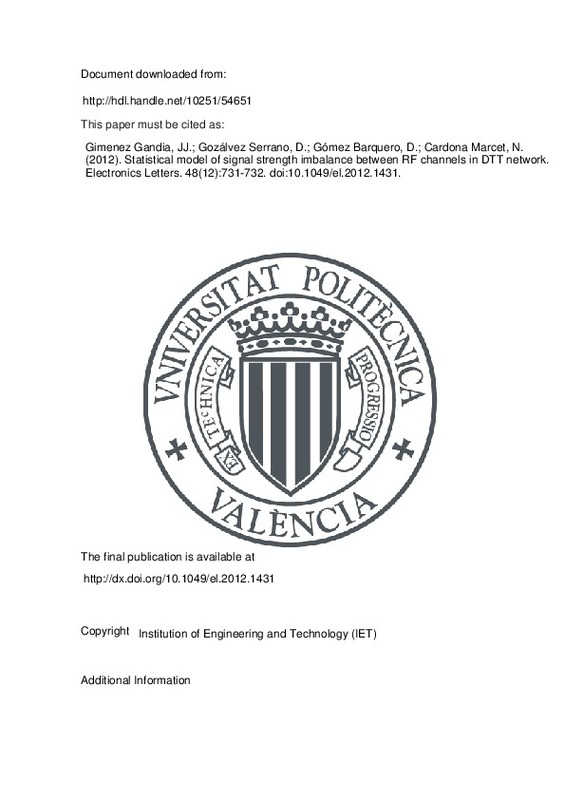JavaScript is disabled for your browser. Some features of this site may not work without it.
Buscar en RiuNet
Listar
Mi cuenta
Estadísticas
Ayuda RiuNet
Admin. UPV
Statistical model of signal strength imbalance between RF channels in DTT network
Mostrar el registro sencillo del ítem
Ficheros en el ítem
| dc.contributor.author | Giménez Gandia, Jordi Joan
|
es_ES |
| dc.contributor.author | Gozálvez Serrano, David
|
es_ES |
| dc.contributor.author | Gómez Barquero, David
|
es_ES |
| dc.contributor.author | Cardona Marcet, Narciso
|
es_ES |
| dc.date.accessioned | 2015-09-15T11:26:47Z | |
| dc.date.available | 2015-09-15T11:26:47Z | |
| dc.date.issued | 2012-06-07 | |
| dc.identifier.issn | 0013-5194 | |
| dc.identifier.uri | http://hdl.handle.net/10251/54651 | |
| dc.description.abstract | Proposed is a model for the received signal strength imbalance between radio frequency (RF) channels in the UHF band. The model is fitted to field measurements carried out in the commercial DVB-T (digital terrestrial broadcasting) network of Sweden. Analysis of the measurement data reveals large differences in the received signal strength between channels according to the reception scenario and the frequency spacing. The model presented is a valuable tool to investigate the potential network planning gains of time-frequency slicing, a technique that was described in the DVB-T2 standard and that will be included in the future DVB-NGH (next generation handheld) standard for improved frequency diversity. © 2012 The Institution of Engineering and Technology. | es_ES |
| dc.language | Inglés | es_ES |
| dc.publisher | Institution of Engineering and Technology (IET) | es_ES |
| dc.relation.ispartof | Electronics Letters | es_ES |
| dc.rights | Reserva de todos los derechos | es_ES |
| dc.subject | Digital terrestrial broadcasting | es_ES |
| dc.subject | Field measurement | es_ES |
| dc.subject | Frequency diversity | es_ES |
| dc.subject | Frequency spacing | es_ES |
| dc.subject | Handhelds | es_ES |
| dc.subject | Measurement data | es_ES |
| dc.subject | Network planning | es_ES |
| dc.subject | Radio frequency channels | es_ES |
| dc.subject | Received signal strength | es_ES |
| dc.subject | Signal strengths | es_ES |
| dc.subject | Statistical models | es_ES |
| dc.subject | Time frequency | es_ES |
| dc.subject | UHF band | es_ES |
| dc.subject | Next generation networks | es_ES |
| dc.subject | Digital video broadcasting (DVB) | es_ES |
| dc.subject.classification | TEORIA DE LA SEÑAL Y COMUNICACIONES | es_ES |
| dc.title | Statistical model of signal strength imbalance between RF channels in DTT network | es_ES |
| dc.type | Artículo | es_ES |
| dc.identifier.doi | 10.1049/el.2012.1431 | |
| dc.rights.accessRights | Abierto | es_ES |
| dc.contributor.affiliation | Universitat Politècnica de València. Instituto Universitario de Telecomunicación y Aplicaciones Multimedia - Institut Universitari de Telecomunicacions i Aplicacions Multimèdia | es_ES |
| dc.contributor.affiliation | Universitat Politècnica de València. Departamento de Comunicaciones - Departament de Comunicacions | es_ES |
| dc.description.bibliographicCitation | Gimenez Gandia, JJ.; Gozálvez Serrano, D.; Gómez Barquero, D.; Cardona Marcet, N. (2012). Statistical model of signal strength imbalance between RF channels in DTT network. Electronics Letters. 48(12):731-732. doi:10.1049/el.2012.1431 | es_ES |
| dc.description.accrualMethod | S | es_ES |
| dc.relation.publisherversion | http://dx.doi.org/10.1049/el.2012.1431 | es_ES |
| dc.description.upvformatpinicio | 731 | es_ES |
| dc.description.upvformatpfin | 732 | es_ES |
| dc.type.version | info:eu-repo/semantics/publishedVersion | es_ES |
| dc.description.volume | 48 | es_ES |
| dc.description.issue | 12 | es_ES |
| dc.relation.senia | 223342 | es_ES |
| dc.description.references | ‘Frequency and Network Planning Aspects of DVB-T2’, May, 2011 | es_ES |
| dc.description.references | Digital Video Broadcasting (DVB); Frame structure, channel coding and modulation for a second generation digital terrestrial television broadcasting system (DVB-T2), ETSI Std. EN 302 755, V2.1.2, February 2011 | es_ES |
| dc.description.references | Gudmundson, M. (1991). Correlation model for shadow fading in mobile radio systems. Electronics Letters, 27(23), 2145. doi:10.1049/el:19911328 | es_ES |







![[Cerrado]](/themes/UPV/images/candado.png)

